Sweet potatoes are up, squash is down
- On: September 21, 2016
 0
0
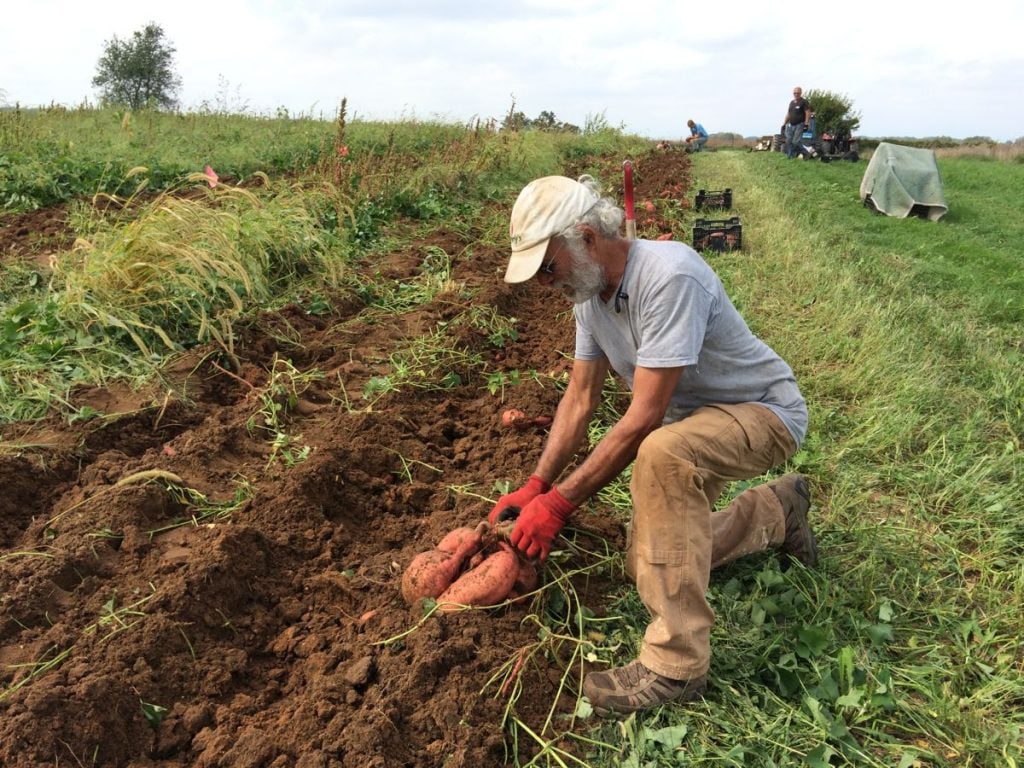
Steve pulls up a beautiful hill of sweet potatoes. Steve undercuts the rows to lift the roots to the surface, then we pick them up by hand. It’s not a fancy method but gets the job done.
We dug our first sweet potato harvest last Friday. This is a preliminary harvest, enough for one CSA delivery. The roots are curing in a hot, steamy room, and will be ready in a week or two. Based on this early sampling, looks to be a good sweet potato year. This surprised us, considering how rainy it’s been. Sweet potatoes grow well in dry, thin soils and (supposedly) dislike wet soil. We did not find any rot as we dug on Friday, which was a relief. If the rest of the fields are as good, we might have enough sweet potatoes for an extra delivery.
Sweet potatoes and winter squash seem to cycle opposite each other. If one crop does poorly, then the other does well. Overall, this is a middling winter squash year. The butternuts look as sturdy and prolific as usual but other types like delicata and acorn squash did not do well. They got really close to harvest, then rotted before ripening. Chalk it up to the wet year. Winter squash is one of “my” crops so I gnashed my teeth a lot as the plants went downhill. However, it was an excellent year to test new varieties! If a variety thrived and produced tasty squash, then it’s probably a keeper. We will send the most promising types to a few sites this week. We’d love to hear what you think of them. Follow the link in the newsletter to give us your feedback.
I have mentioned the wet weather frequently this summer but we remain grateful that the spring weather was dry. Our biggest problem now is that weeds are overtaking our farm. Steve and Jeremy cultivated repeatedly but the weeds re-root each time it rains. I’ve talked with a few farmer friends over the past weeks and all expressed impatience to get this season finished. We’ve heard difficult stories from friends in western Wisconsin and Minnesota where it has rained all season. Here’s a piece written by a farmer friend struggling to grow vegetables in Minnesota, and wondering if our climate is suited to vegetable production at all.
Beth
Willy Street Parade
The highlight of our week was our annual trip to the Willy Street parade. As usual, we were fueled by our crew’s enthusiasm and creativity. Maggie printed a new Tipi t-shirt, based on Karen’s artwork. It is so lovely. We handed out Oranos peppers and Romano beans. The peppers got a much more enthusiastic response!
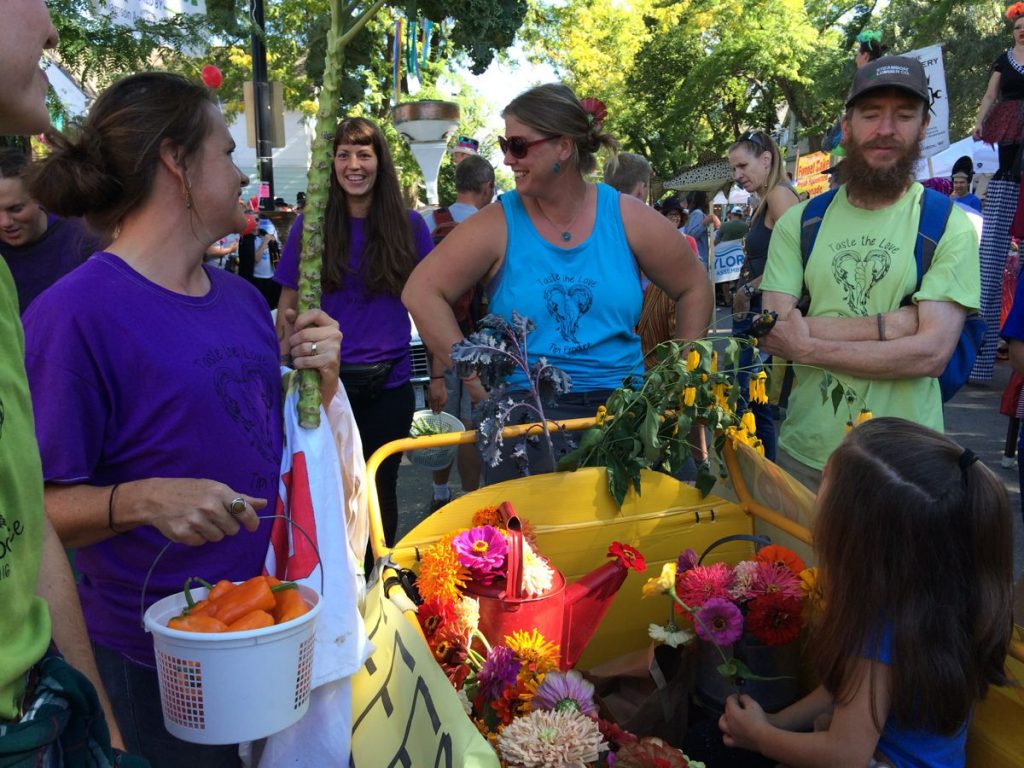
Karen, Charlotte, Maggie, Ken (Tipi alumnus) and Charlotte’s daughter prepare for the parade. Maggie loaded her new pedi-cab with flowers to toss to the crowd.
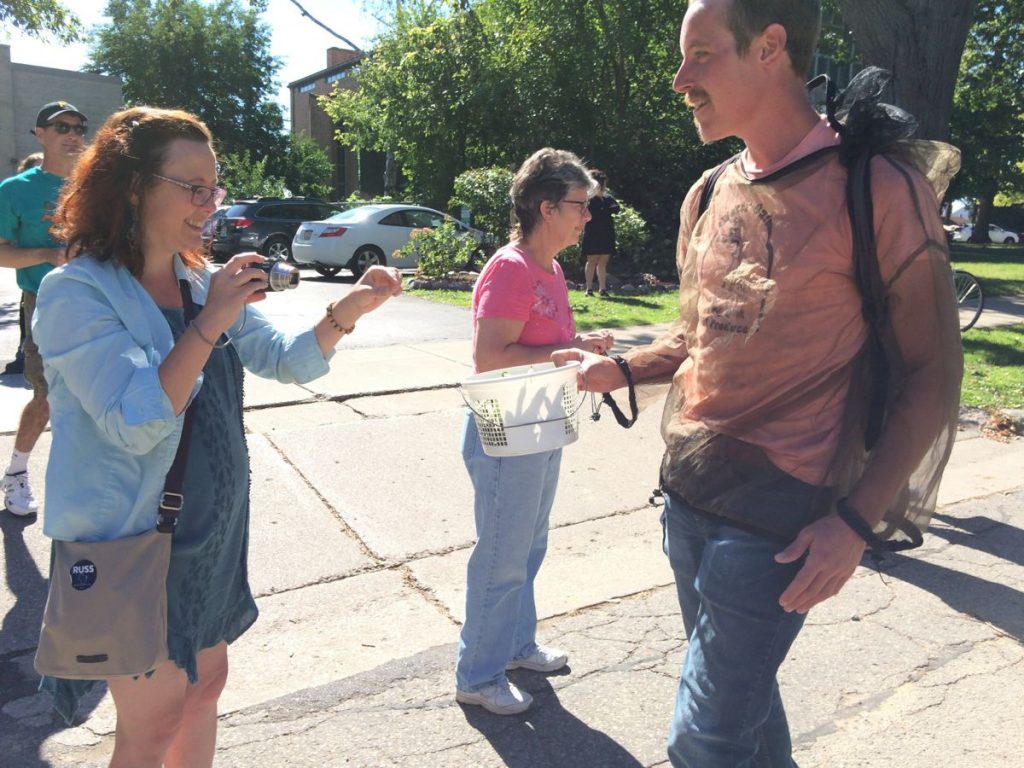
James hands out beans, wearing a mosquito net. They are our uniform these days.
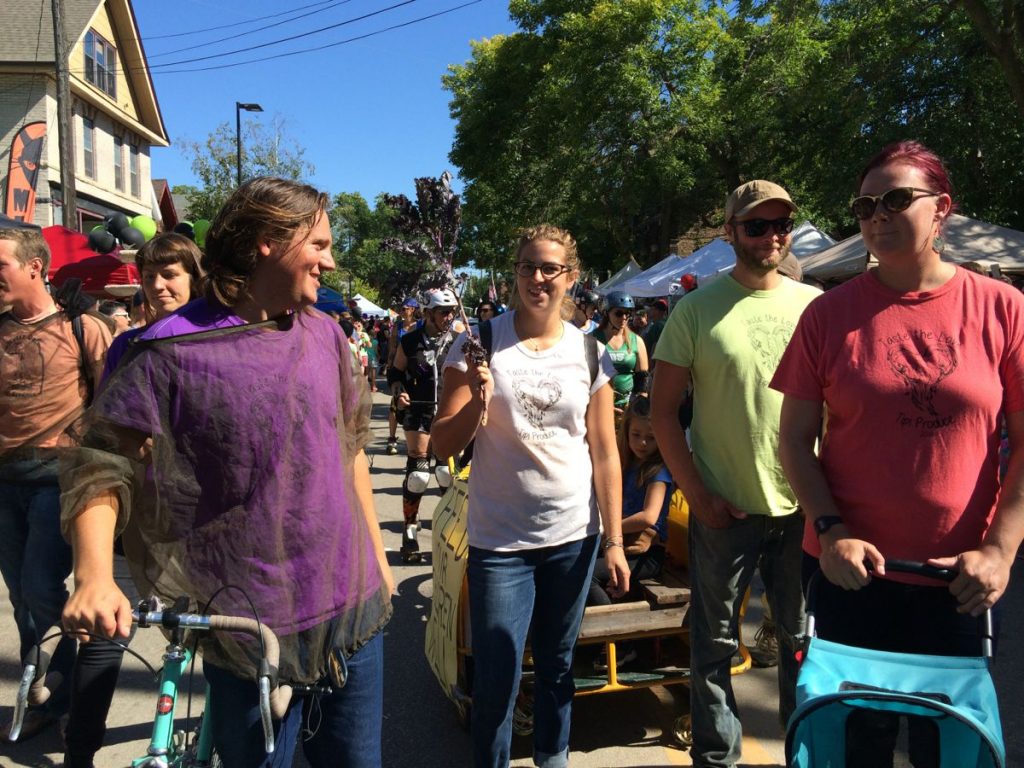
James, Charlotte, Jory, Kelsie, Jim and Madeleine.

Our tallest fan enjoys a pepper.
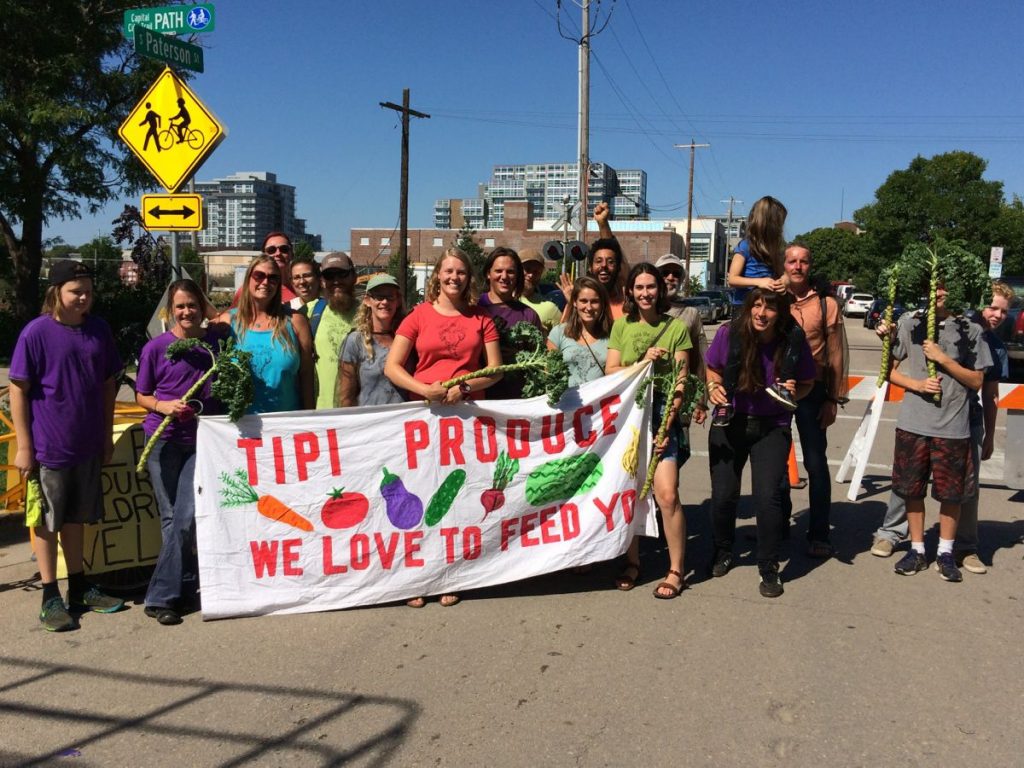
The parade crew assembled. It’s not the entire Tipi crew but was a good turnout.
Veggie list and veggie notes (Sept 22/23, 2016, week #19, green EOW)
Hey folks, we were going to pack a few final plum tomatoes in this week but decided against it. They just weren’t good enough.
Green cabbage
Broccoli
Carrots, 2 lb
Leeks, 1 lb
Lacinato or red kale, 1 bunch
Yellow onions
Red or yellow frying peppers, ~5
Snack peppers (Oranos or Lunchbox)
Basil (Italian or Thai)
Garlic
Some sites get a small winter squash.
Some sites get larger portions of cabbage &/or broccoli.
Some sites get an extra bell pepper or two.
Next week’s box will probably contain potatoes, leeks, broccoli, carrots, peppers and more.
Leeks (look like big scallions) – These alliums have a milder flavor than onions. Nonetheless, they can be used in recipes that call for onions. To wash, split the leek lengthwise, from the green tops about halfway to the base, leaving the base intact. Rinse well under running water, separating the layers to flush. If necessary, split the leek further if soil has penetrated more than halfway down the leek. Shake dry. Leeks are generally eaten cooked. They can be sauteed, steamed or roasted. Intact leeks will store 2 to 3 weeks if covered loosely and refrigerated. The outer leaves will yellow. Just peel them off and discard. The inner leek layers will be fine.
Lacinato (dark green) or red kale – The kale needs to be fully cooked until tender. It is not tender enough for light wilting or a rubbed salad.
Frying peppers – Good grief, the frying peppers are abundant right now. We’ve sent enough this time for you to make a batch of stuffed peppers. These peppers are very ripe. They are full-flavored but will not store for long.
Plum tomatoes – We’ve sent just a few last tomatoes. It’s hard to let go. Use for cooking rather than fresh use – it’s that time of year.
Basil – This is the last basil for the year.
Garlic – This garlic is from John Hendrickson of Stone Circle Farm.
Winter squash – Some sites will receive a small winter squash. Many are new varieties we tried for the first time this year. Much of the interesting breeding work for flavor has focussed on small single-portion squash so these are small varieties. Most types are on the delicata to acorn spectrum. That means … (1) they are ripe and ready to eat, and (2) these are not designed for storage. Eat soon.
Storage: Store at room temperature, uncovered.
Preparation: Winter squash are easily roasted in a 400F oven. Split in half with a sharp knife. Scoop out and discard seeds. Run the squash under running water, shake off the excess and place cavity-side-down on a baking sheet. The little bit of moisture helps seal the squash to your roasting pan. The water soon evaporates, allowing the squash to brown and caramelize. Roast at 400F until easily pierced with a fork, 20 – 40 minutes depending on size.
To make squash easier to cut, microwave on high from 30 seconds to a minute, depending on the size of the squash, soften the rind and flesh.
RECIPES FROM LAUREN
CURRIED CARROT SOUP
Adapted from Bon Appetit
I use a combination of butter and oil because I love the way butter tastes in soup when cooked low and slow with veggies for a while, but if you are vegan, feel free to use all olive oil. It really won’t impact the flavor much. Also,† you can use a tablespoon of any curry powder you have laying around. We have these really nice hot and sweet variations from The Spice House and have discovered the perfect ratio of each to yield a sweet soup with a subtle degree of heat.
Takes 1 hour, 20 minutes
Makes 6 cups
2 tablespoons butter
2 tablespoons olive oil
1 pound of leeks, diced
4 garlic cloves, minced
Kosher salt
Freshly ground black pepper
1 pound carrots, peeled and roughly chopped
2 teaspoons sweet curry powder
1 teaspoon hot curry powder
1 teaspoon siracha hot sauce
13.5-ounce can coconut milk
4 cups chicken (or vegetable) stock
Add butter and oil to a large stock pot. Melt butter over medium-low heat. Add the leeks and garlic as well as a sprinkling of salt and pepper. Cook until leeks are translucent and fragrant, about 10 minutes. Add the carrots and hot sauce and turn the heat up to medium. Cook for 20 minutes, stirring occasionally. Add the spices, coconut milk and stock. Bring to a boil, reduce to a simmer and cook for 30 minutes until carrots are tender and liquid is nicely reduced.
Let cool and puree with an immersion blender. We don’t puree until completely smooth. We like some small chunks of carrot in there, but that is up to you. Taste and adjust seasoning. Top with chickpeas if you are feeling extra fun!
CUMIN ROASTED CHICKPEAS (optional)
15-ounce can chickpeas, drained and rinsed
2 tablespoons olive oil
2 teaspoons ground cumin
1-2 teaspoons Kosher salt
Freshly ground black pepper
Preheat oven to 400 degrees. Toss chickpeas with oil, cumin, salt and pepper. I use 1 teaspoon of salt if I’m making these chickpeas for my carrot soup (because it’s already a little salty) and 2 teaspoons of salt if I’m making these chickpeas as a non-soup-addition, generally-delicious snack. Roast for 20 minutes or until crunchy. Take out the pan and shake it occasionally for more even crisping.
———-
SEPTEMBER VEGGIE, SHRIMP & SOBA NOODLE SALAD WITH PEANUT DRESSING
Adapted from Gourmet MD
Takes 1 hour, 30 minutes inactive
Serves 4-6
8 ounce package buckwheat (soba) noodles
1 tablespoon toasted sesame oil (regular oil will do just fine in a pinch), divided
1 pound medium or large shrimp, peeled and deveined
Kosher salt and freshly ground black pepper, to taste
1 head broccoli
1 cup shredded cabbage
1 red frying pepper, thinly sliced
1 yellow frying pepper, thinly sliced
2 carrots, cut into matchsticks
1 onion, very thinly sliced
1/2 cup roasted peanuts
thinly sliced basil, to taste
Peanut dressing:
6 tablespoons peanut butter (I love to use any YumButters I have on hand for these kind of sauces)
1/4 cup brown sugar
1/4 cup soy sauce or tamari
3 tablespoons toasted sesame oil
1 tablespoon Sriracha
Zest and juice of 2 limes
Splash hot water if too thick
- Cook soba noodles according to package directions. Drain and rinse with cold water for about a minute to cool the noodles and stop the cooking process. Place in a large bowl and drizzle with 1/2 tablespoon sesame oil. Put in fridge until ready to use.
- Heat remaining sesame oil in a large frying pan over high heat. Add spring, season with a good amount of salt and pepper. Saute 60-90 seconds until shrimp is opaque and begins to curl. Remove from skillet and allow to cool.
- Stir together all dressing ingredients in a small bowl until smooth. Add hot water if it’s too thick.
- Cut off broccoli florets and roughly chop into bite-size pieces. Save stem and cut into small matchsticks (similar size to carrots). Add broccoli along with cabbage, peppers, carrots and shrimp to noodle bowl.
- Add dressing and toss to coat. Return to fridge for at least 30 minutes to cool and let flavors come together.
- Add onion, peanuts, and basil just before serving.
———-
LOCAL THYME RECIPES
Comforting Classics
Creamy White Bean Soup with Kale Pesto
Roasted Red Pepper Pesto
Garlicky Braised Leeks and Cabbage
Zabar’s of New York “Health Salad”
Outside the Box Recipes
Thai Braised Kale
Fajitas Rice Bowl
Bacon, Leek and Gruyere Strata
Carolina Cabbage and Carrot Slaw
Quick and Easy Meal



